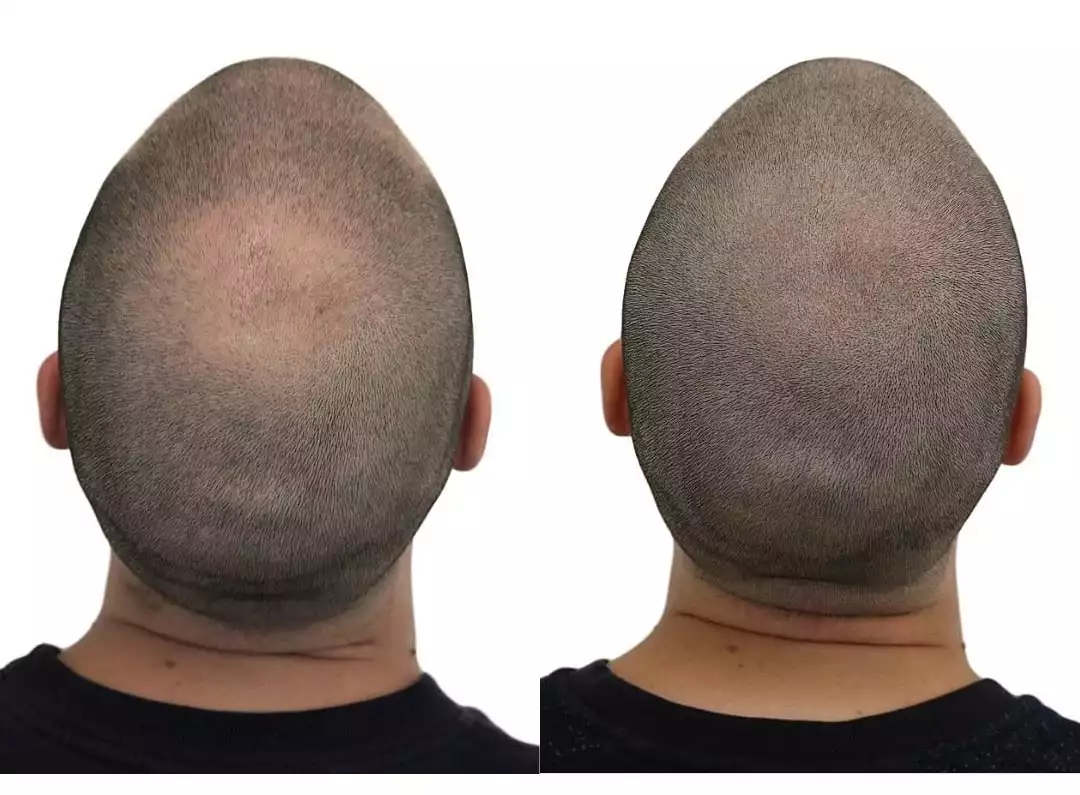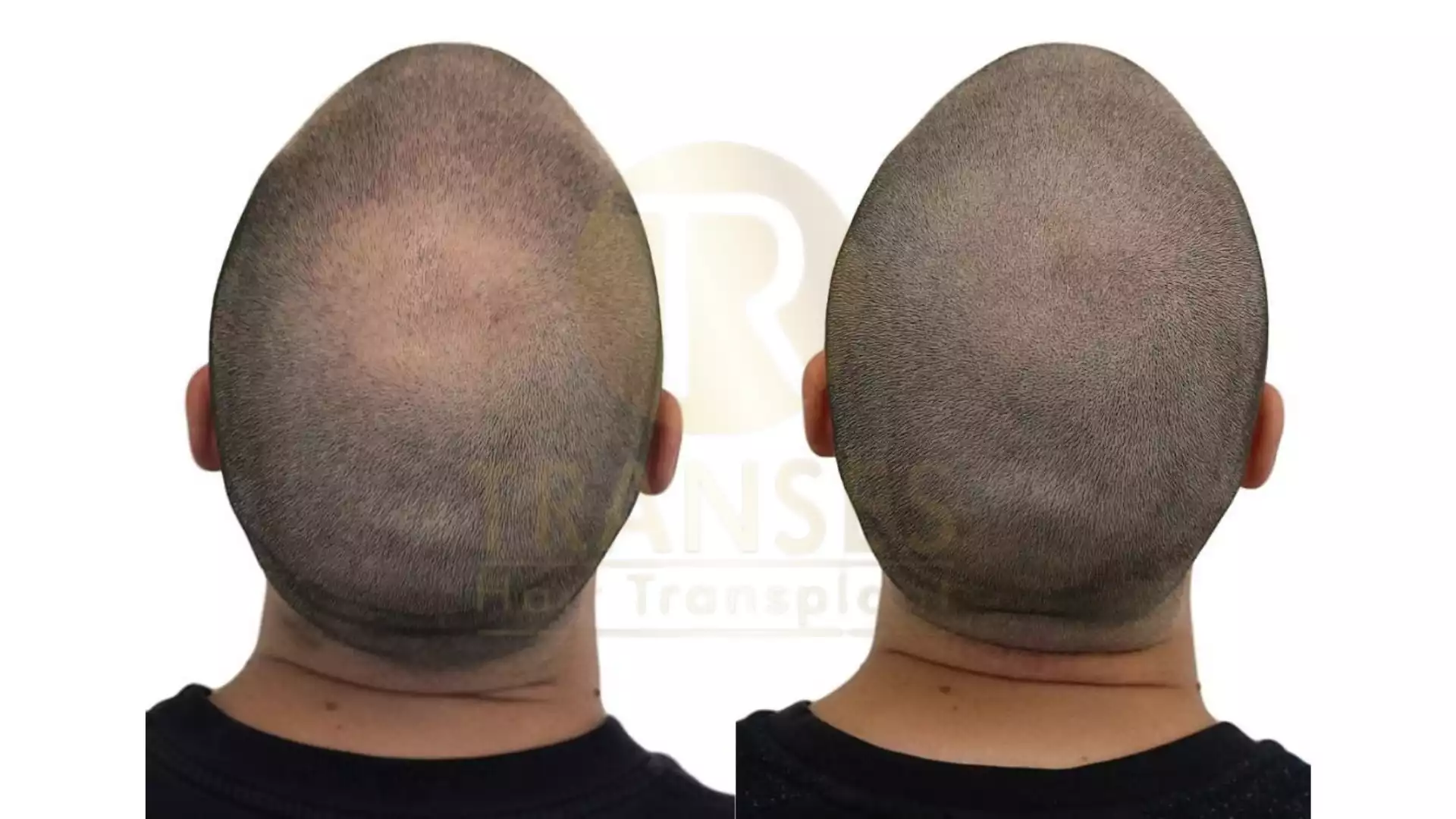Customer Service
+90 546 449 4247

What is Scalp Micropigmentation?
Scalp micropigmentation is a cosmetic procedure applied to provide an aesthetic solution to people with hair loss or sparse hair problems. It is also called “scalp micropigmentation” or “scalp tattooing”. Scalp micropigmentation involves injecting pigments into the scalp through a special device to create the impression of natural-looking hair.
During this procedure, a specialized technician places tiny dots of pigment on the scalp to mimic the hairline and make the hair appear denser and fuller. These dots are injected at regular intervals to mimic the natural shape and distribution of the hair follicles. This makes the hair appear thicker and denser.
Scalp micropigmentation can be an option for men and women suffering from hair loss, thinning hair, baldness, or hairline loss. It can also be used to camouflage bald patches or scars.
Scalp micropigmentation can be applied with different techniques that can be temporary or permanent. Depending on the person’s preferences, needs, and the expert’s recommendations, the procedure can be customized.
This procedure has gained popularity among people looking for a temporary or non-surgical option to improve the appearance of their hair. However, it is important to consult a specialist who performs such procedures and to make sure that the person performing the procedure is experienced and skilled.
Hair Transplant Scar Treatment
Scalp micropigmentation is a method used to camouflage hair transplant scars. After hair transplantation, scars may appear on the scalp. These scars can often be red or white in color and can be an aesthetic concern for some people. Scalp micropigmentation is a cosmetic procedure used to camouflage these scars and make the hairline look more natural. In this procedure, a technique called micropigmentation is used. Pigments are injected into the skin surface with a fine micro-tipped instrument. These pigments are selected to match the hair color, and are used to bring the color and appearance of the scars closer to the natural hair color.
The scalp micropigmentation procedure is usually performed by a scalp micropigmentation specialist. The procedure may usually require several sessions. The time between sessions is determined taking into account the time needed for skin healing.
Scalp micropigmentation can be an effective solution to hide hair transplant scars. However, it may not be suitable for everyone, and results may vary individually. Therefore, if you are considering scalp micropigmentation, it is important to consult a specialist. The specialist can assess your situation and determine the most appropriate treatment options for you.
Treating Alopecia with Scalp Micropigmentation
Scalp micropigmentation is a method also used for the treatment of hair loss problems such as alopecia. Alopecia is a condition that leads to hair loss, usually as a result of inflammation of the hair follicles or an autoimmune reaction.
Scalp micropigmentation can be used to improve the appearance of the scalp in the hair loss areas. In this procedure, a technique called micropigmentation is used. Pigments are injected into the gaps or sparse areas of the scalp with a micro-tipped instrument. These pigments are selected in a color close to the natural hair color and make the scalp appear denser and fuller.
Hair simulation can be used to recreate the hairline, fill gaps in the scalp, or improve the overall appearance of the scalp in people with hair loss due to alopecia. This method can be preferred as an option that does not require hair transplantation or medication.
However, scalp micropigmentation does not cure alopecia, it only improves its appearance. It is therefore important to address the underlying problem causing the alopecia. It is important to consult a dermatologist or a specialist for the treatment of alopecia. The specialist can assess your situation and recommend the most suitable treatment options and provide more information about the scalp micropigmentation procedure.
Scar Camouflage Tattooing
Scalp micropigmentation can be an effective method to hide scars. Scars can be caused by a wound, surgery, or accident, and usually leave a permanent mark on the skin. Scalp micropigmentation is a cosmetic procedure used to hide these scars and create a more natural hairline.
The scalp micropigmentation procedure is performed using a technique called micropigmentation. Pigments are injected into the skin surface using a fine micro-tipped instrument. These pigments are selected to match the scar color, and are used to bring the color and appearance of the scar closer to the hair color. This makes the scar less noticeable and gives the scalp a more natural appearance.
However, scalp micropigmentation may not be suitable for everyone, and results may vary individually. If you are considering scalp micropigmentation, it is important to consult a specialist. The specialist will assess the condition of the scar and determine the most suitable treatment plan for you. It is also important that you follow the post-procedure care instructions and follow the recommendations.
Hair Transplant SMP Combinations
Yes, scalp micropigmentation can also be combined with hair transplantation. Hair transplantation is a surgical procedure that involves removing healthy hair follicles from the scalp and transplanting them to areas of baldness or thinning. However, the healing process and new hair growth after hair transplantation can take several months.
After hair transplantation, scalp micropigmentation can be used to camouflage scars in the transplanted areas, and make the scalp look fuller and more natural. The scalp micropigmentation procedure involves injecting pigments into the skin in the transplanted areas with a fine micro-tipped instrument. These pigments are selected to match the natural hair color and make the hairline more defined.
Hair transplantation and scalp micropigmentation procedures are usually performed at separate stages. If hair transplantation is completed first, scalp micropigmentation can be performed 3 months after hair transplantation; if scalp micropigmentation is to be performed first, hair transplantation can be performed 1 month after the procedure. In this way, the results obtained after hair transplantation gain a more natural and aesthetic appearance.
Hair transplantation and scalp micropigmentation are complex and specialized procedures. Therefore, it is important to consult a specialist. The specialist will assess your situation, determine the most appropriate treatment plan, and coordinate the hair transplant and scalp micropigmentation procedures.
Repairing a Bad SMP Procedure
If you are faced with a badly done scalp micropigmentation application, you can follow the steps below:
1-Get a specialist opinion: In the case of a badly done scalp micropigmentation, it is important to get a professional opinion from a scalp micropigmentation specialist. The specialist will assess the situation and recommend the most appropriate correction options.
2-Make contact: Contact the person or center that performed the scalp micropigmentation application and explain the problem you are experiencing in detail. If there is a guarantee or satisfaction policy, ask about it.
3-Evaluate correction options: Your specialist can offer various options to correct a badly done scalp micropigmentation. These may include pigment correction, pigment addition, or removing and redoing the existing micropigmentation. Pay attention to the specialist’s recommendations to determine the most suitable option for you.
4-Be patient: Correcting a badly done scalp micropigmentation can take time. The healing and correction process may require several sessions or longer. Be patient and follow your specialist’s recommendations.
5-Choose a new specialist for a proper application: If you have had a bad scalp micropigmentation experience, it is important to choose a new specialist to do the correction. You can apply to a specialist who has references, experience, and has achieved successful results.
6-Pay attention to care after application: After the new micropigmentation application, it is important to carefully follow the instructions given to you by your specialist. In order to maintain the permanence and healthy appearance of scalp micropigmentation, it is necessary to take the right care measures.
It may be possible to fix a badly done scalp micropigmentation, but it is important to choose the right specialist and follow a professional approach. It is important to determine the best correction option based on specialist advice and take the right steps to have the procedure redone.
Hairline Restoration
Scalp micropigmentation can be an effective method for hairline restoration. The hairline determines how the hair is positioned at the front of the head and the transition of the hair to the rest of the head. An aesthetically appropriate hairline provides a natural and symmetrical appearance.
Hairline repair is used to correct the hairline distortions or restore the hairline. This is usually caused by a hair transplant, an incorrectly made hairline, or regression of the natural hairline. Scalp micropigmentation is used to camouflage irregularities or gaps in the hairline and achieve a more natural look.
The scalp micropigmentation procedure is performed using a technique called micropigmentation. Using a fine micro-tipped instrument, pigments suitable for the hairline are injected into the skin surface. These pigments are selected to match the natural hair color and make the hairline more defined and look natural.
Hairline restoration with scalp micropigmentation should be performed by a scalp micropigmentation specialist. The specialist will assess the problems in the hairline and determine the most suitable treatment plan for you. The procedure may usually require several sessions.
However, scalp micropigmentation may not be suitable for everyone, and results may vary individually. If you are considering hairline restoration with scalp micropigmentation, it is important to consult a specialist. The specialist will assess your situation and recommend the most suitable treatment options and provide more information about the procedure.










